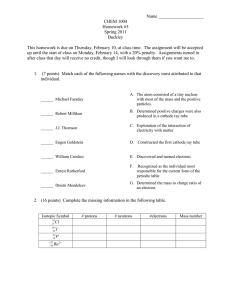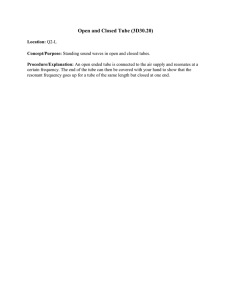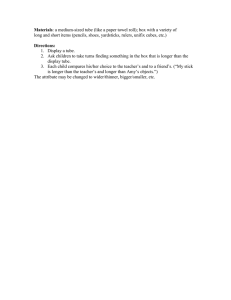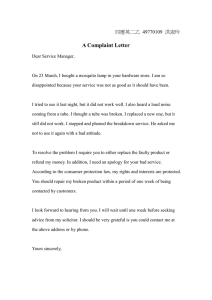"AN ADVANCED COLOR TELEVISION RECEIVER USING A
advertisement
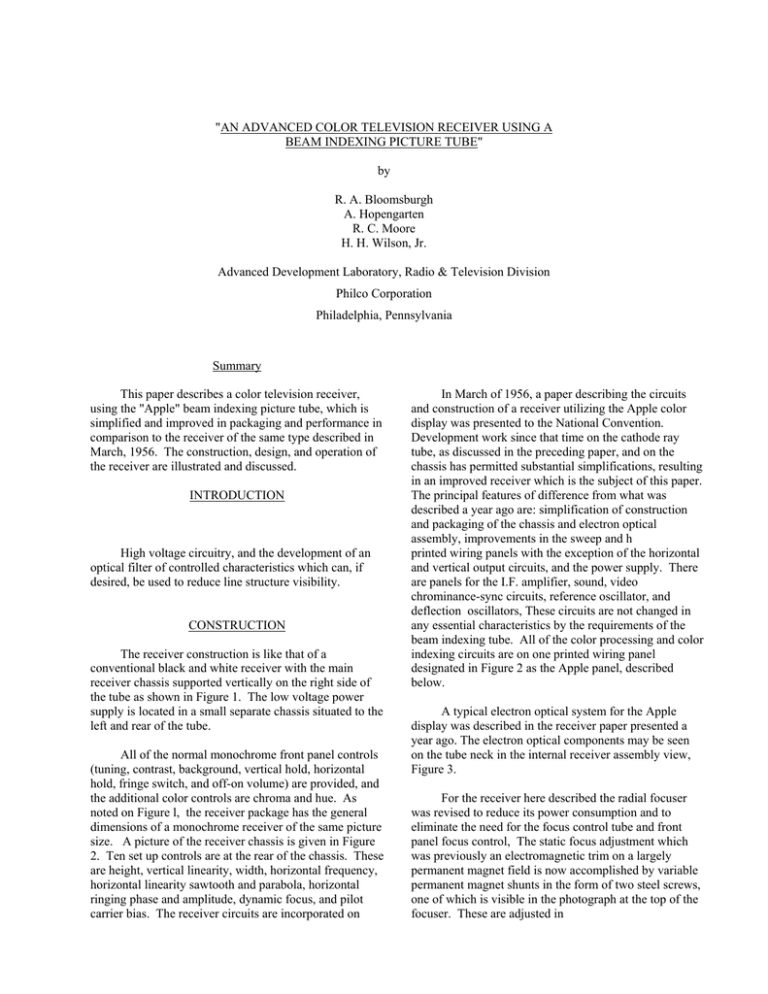
"AN ADVANCED COLOR TELEVISION RECEIVER USING A BEAM INDEXING PICTURE TUBE" by R. A. Bloomsburgh A. Hopengarten R. C. Moore H. H. Wilson, Jr. Advanced Development Laboratory, Radio & Television Division Philco Corporation Philadelphia, Pennsylvania Summary This paper describes a color television receiver, using the "Apple" beam indexing picture tube, which is simplified and improved in packaging and performance in comparison to the receiver of the same type described in March, 1956. The construction, design, and operation of the receiver are illustrated and discussed. INTRODUCTION High voltage circuitry, and the development of an optical filter of controlled characteristics which can, if desired, be used to reduce line structure visibility. CONSTRUCTION The receiver construction is like that of a conventional black and white receiver with the main receiver chassis supported vertically on the right side of the tube as shown in Figure 1. The low voltage power supply is located in a small separate chassis situated to the left and rear of the tube. All of the normal monochrome front panel controls (tuning, contrast, background, vertical hold, horizontal hold, fringe switch, and off-on volume) are provided, and the additional color controls are chroma and hue. As noted on Figure l, the receiver package has the general dimensions of a monochrome receiver of the same picture size. A picture of the receiver chassis is given in Figure 2. Ten set up controls are at the rear of the chassis. These are height, vertical linearity, width, horizontal frequency, horizontal linearity sawtooth and parabola, horizontal ringing phase and amplitude, dynamic focus, and pilot carrier bias. The receiver circuits are incorporated on In March of 1956, a paper describing the circuits and construction of a receiver utilizing the Apple color display was presented to the National Convention. Development work since that time on the cathode ray tube, as discussed in the preceding paper, and on the chassis has permitted substantial simplifications, resulting in an improved receiver which is the subject of this paper. The principal features of difference from what was described a year ago are: simplification of construction and packaging of the chassis and electron optical assembly, improvements in the sweep and h printed wiring panels with the exception of the horizontal and vertical output circuits, and the power supply. There are panels for the I.F. amplifier, sound, video chrominance-sync circuits, reference oscillator, and deflection oscillators, These circuits are not changed in any essential characteristics by the requirements of the beam indexing tube. All of the color processing and color indexing circuits are on one printed wiring panel designated in Figure 2 as the Apple panel, described below. A typical electron optical system for the Apple display was described in the receiver paper presented a year ago. The electron optical components may be seen on the tube neck in the internal receiver assembly view, Figure 3. For the receiver here described the radial focuser was revised to reduce its power consumption and to eliminate the need for the focus control tube and front panel focus control, The static focus adjustment which was previously an electromagnetic trim on a largely permanent magnet field is now accomplished by variable permanent magnet shunts in the form of two steel screws, one of which is visible in the photograph at the top of the focuser. These are adjusted in a radial direction to by-pass a portion of the permanent flux and provide a 10% range without beam rotation or spot distortion. The vertical focus current of parabolic waveform is then derived from the vertical sweep by a passive integrating network. The yoke winding distribution has been modified to improve edge focus. As noted in the companion paper just presented, the color line geometry is now matched to the natural raster geometry resulting from the combined effects of yoke field and tube geometry. This is feasible since the beam tracking correction is now incorporated in the index line structure, permitting the elimination of sweep width modulation. The parallel construction of the horizontal windings has been continued in the present yoke design as an effective way of minimizing internal yoke ringing. The mounting and alignment of the electron optical components has been substantially revised. Both yoke and focusser are supported closely concentric to the tube neck by utilizing the self aligning properties of a double cone. Each component is provided with a tapered internal polyethylene liner. The insertion of a plastic cone having a matching taper automatically aligns and supports the component on the tube neck in the presence of commercial glassware tolerances. The yoke cone is visible in Figure 3. No lateral adjustment is provided for either yoke or focusser. This design has eliminated the cup, rods and wobble plate previously used for support and alignment. The beam alignment magnet is used, as described last year, to make the beam concentric with the tube neck. The device labeled "shield structure" is a flexible aluminum cover over the index signal takeoff coatings on the cathode ray tube. The Apple Tube-unit assembly is shown in Figure 4. The index signal is derived from the face of the cathode ray tube by providing two silver bands painted on the glass of the cathode ray tube along the top and bottom of the face. These couple by capacity to the cathode ray tube screen. The cathode ray tube mounting band is grounded. A cable is connected to each silver band by a set of spring fingers which are mechanically attached to, but insulated from, the tube mounting band. Each of these structures is partially tuned by a fixed coil mounted between the spring fingers and the cathode ray tube mounting band. The cables, which are of equal length, are joined and connected to the side-band amplifier input circuit. This input circuit is double-tuned and provides a considerable portion of the total index signal path selectivity. The cathode ray tube funnel is covered with silver paint for shielding purposes. This replaces the separate foil-coated cardboard shield of the earlier receiver. The paint extends forward under the grounded mounted band. In addition, flexible aluminum fingers noted in Figure 3 contact the band and extend forward to the cabinet frame to provide shielding of the index patches. Another view of the receiver chassis is shown in Figure 5. It should be noted again that all of the active circuits subsequent to the 3.6mc chroma amplifier for processing the chroma information and all of the active index circuitry peculiar to this type of display are contained on this one Apple panel. Details of component layout in the high voltage cage may be seen here. The cathode ray tube socket is mounted on a small metal plate. This metal plate supports tuned circuits for the 6.4mc color writing signal output stage and the 41.0mc pilot carrier frequency circuit. Both writing and pilot carrier frequency signals are coupled to the circuits on the socket plate by twisted-pair links. A bottom view of the receiver chassis is shown in Figure 6. The usual assortment of bypass condensers, dropping resistors, and sweep circuitry not contained on printed panels appears here. RECEIVER CIRCUIT FUNCTIONS A functional diagram of the receiver is shown in Figure 7. Blocks enclosed in dotted or solid lines are the separate printed panels. The Apple panel, the large dotted block at the left, includes the index amplifier and the mixers which convert the index signal to the color writing signal as well as the pilot carrier oscillator and a width-control discriminator. The discriminator supplies an output voltage which varies as the index frequency (47.4mc) varies. The discriminator output is filtered to contain only dc and variations much slower than 60cps. This output controls the grid bias of the horizontal output tube to hold the average sweepwidth constant with variation in line voltage and with slow tube and circuit changes. The 6.4mc writing signal amplifier consists of a 6CB6 and a 6CL6. The output transformer is combined with the luminance output circuit and is capable of delivering about 200 volts peak to peak of 6.4mc to the cathode ray tube. The I.F. amplifier second detector drives a triode signal separation stage. The triode has a 4.5mc sound transformer primary as its plate circuit from which the sound signal is separated, and a constant impedance network as a cathode load. The luminance signal is taken from the cathode through the delay line and a two stage amplifier. The chromaticity signal is taken from the high pass section of the constant impedance network and is amplified in the pentode section of a 6AW8 from which the reference system and chroma mixer are driven. The elimination of the width modulation requirement to secure constant frequency of the index signal has resulted in a substantial simplification in the operation of the horizontal sweep-high voltage section. Obviously, the generation and control of special waveforms from the vertical sweeps to effect the width modulation is no longer necessary. Additionally, the elimination of width modulation has made the operational requirements of horizontal deflection like that of monochrome practice, that is, identical horizontal waveforms and sweep power on every scanning line. This has reduced the peak power requirement in the output tube, with obvious advantages. Since linearity has to be maintained only at a constant width it has been found unnecessary to regulate the plate supply of the horizontal oscillator or to use a separate horizontal discharge tube, as was done in the receiver described last year. HORIZONTAL SWEEP HIGH VOLTAGE CIRCUIT A circuit of the horizontal sweep is given in Figure 8. This shows a new anti-ringing circuit which does not require the use of the ringing damper tube of the earlier design. The circuit in essence consists of a damped tuned circuit in series with the low side of the output transformer so as to damp the duration and amplitude of the transients in the output transformer. The remaining ringing voltage existing at the top of the yoke due to the finite damper impedance is cancelled as far as the yoke is concerned by developing a similar voltage at the bottom of the yoke. This is derived from an auxiliary winding on the damped tuned circuit. Ringing phase and amplitude controls handle like the usual knobs to balance a bridge. In this circuit is shown a new type of sawtooth linearity control which varies simultaneously the yoke circuit resistance and the magnitude of a voltage sawtooth applied to the damper plate. This adjustment and that of the parabolic component of linearity control are independents. With these circuit improvements, the requirements for very high perveance of the horizontal damper are relieved appreciably. A low-gain triode DC amplifier, the 6BJ8T, and a small voltage-reference gas tube, L1329, have been added to the width control circuit to eliminate the separate index mixer and discriminator driver amplifier which were in the earlier circuit. The tube count in the sweep H.V. focus circuitry in this Receiver is four less than in the receiver described last year. OPTICAL FILTER The screen structure of an Apple tube is visible to some extent to a viewer at moderately close range. It comprises a pattern of vertical phosphor lines laid down with pitch separation of 60 mils between like colors. Since the use of a smaller pitch would reduce the brightness saturation capability of the tube for a given spot size it is desirable to attack the structure visibility from another point of view. Considerable reduction of the line visibility has been achieved through the use of geometric filters applied directly to the tube face. The basic requirements for such means for suppressing structure visibility are as follows: 1. The visibility of the color lines should be reduced to a tolerable limit at close viewing distances. It is quite sufficient for practical purposes to take this limit equal to the visibility of the normal scanning line structure. 2. Resolution of picture information within the normal luminance frequency band width should not be adversely affected. 3. Side effects such as moiré and ambient light reflections should be negligible. Optical diffusion screens to serve these purposes have been developed in various forms. One typical structure comprises an assembly of periodic vertical cylindrical lenses (200 per inch) which are molded by conventional techniques in a thin sheet of transparent plastic. The lens element pitch and radius can be so chosen that considerable diffusion of the color line structure is achieved without significant loss of normal details This selective action is possible since the color triplets effective recur at a "frequency" of 6.4mc. In principle, the lenticular assembly can be considered as an optical filter having a (sin x)/x response with the first zero positioned at the triplet frequency, Moiré effects are quite low. A second type of optical filter has been developed which comprises a set of randomly spaced vertical grooves whose average optical parameter likewise provide selective diffusion near the triplet frequency. This latter type is completely free of moiré, has an unobtrusive appearance under ambient light and appear capable of fabrication at very low cost. None of these filters have any diffusion in a vertical direction, so that resolution of vertical detail is not affected. Figure 9 shows experimental results obtained with an experimental optical filter of the second type. The solid curve shows the attenuation vs frequency characteristic of the optical filter. The principal points of interest are the low attenuation in the luminance bandwidth and the rapid attenuation rise near the triplet frequency of 6.4mc. for broad comparison purposes the attenuation vs. frequency characteristic of a typical monochrome tube due to its spot aperture size is shown in the dashed line. Because of its small spot the Apple shows a relatively small aperture effect. CONCLUSION The receiver here described represents the next stage of development of color receivers utilizing the beam indexing type of color display cathode ray tube subsequent to the receiver described last March. As such, it incorporates: 1. Improved packaging of the chassis components into a color receiver the same sine as a monochrome receiver of the same picture area. 2. Simplification of chassis circuitry and electron optics in important areas, resulting in a set-up and alignment procedure which is significantly easier and quicker than the earlier receiver. 3. Improvement in the available brightnesssaturation product due to the "wide red line" phosphor structure, which provides color pictures of approximately 50% greater brightness for the same beam current. 4. Optionally, the use of an optical filter to reduce line structure visibility at moderately close viewing distances without impairing the excellent inherent resolution capability of the Apple cathode ray tube. ACKNOWLEDGEMENT Many engineers have contributed to the development described in this paper. J. B. Chatten and J. E. Wilcox of the Philco Research Division were active in the optical filter investigation. The receiver development program was directed by W. P. Boothroyd. Since, unhappily, all contributors cannot be listed as co-authors, their names, here following, appear last but not least: J. F. Beres, H. B. Collins, R. S, Gudis, D. E. Marshall, Jr., E. J. Quinlan, P. W. Scholtes, and P. G. Wolfe.
